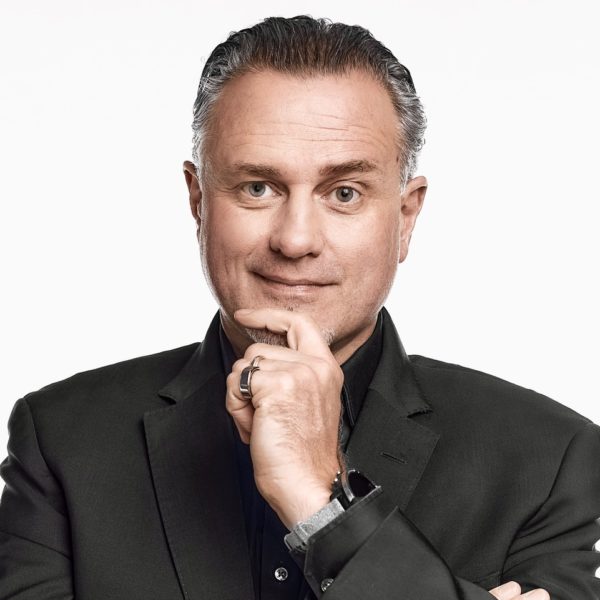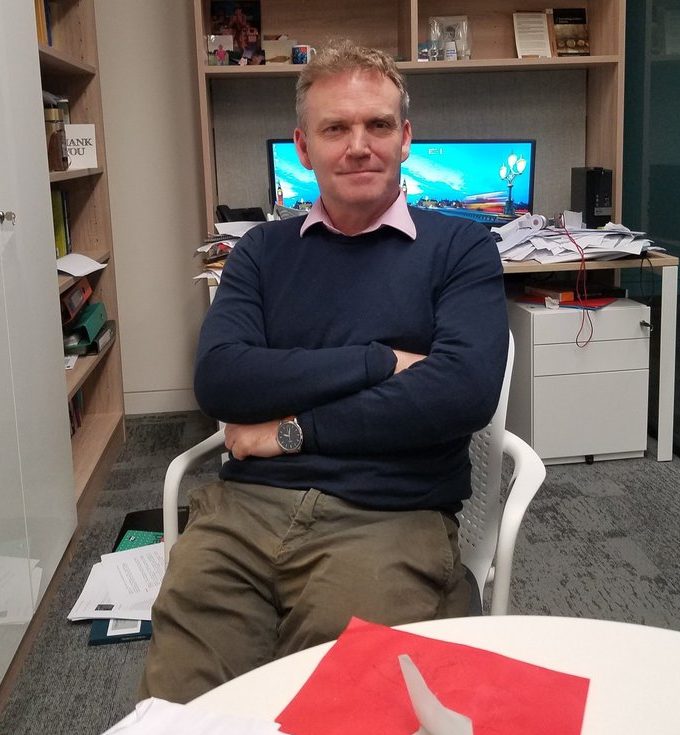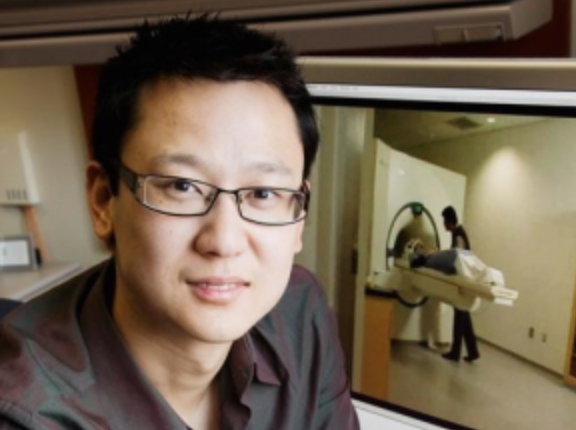
Olaf Groth is a global thought leader on emerging tech (e.g. AI), business strategy, and the changing global economy, with a rich professional background spanning executive roles in multinational corporations, advisory work for governments and corporations, and global convening roles as a member of the Global Alliance for AI Governance at the World Economic Forum, the Astana International Forum and Malaysia’s National AI Office. He brings all of this work to his teaching at Berkeley Haas, where he teaches courses like Disruption Futures/Foresight, Global Strategy, Strategic Leadership, AI and the Future of Business, as well as Berkeley Executive Education, where he is the Faculty Director for “Future of Technology / Emerging Tech Strategies.”
Tim: We’ve talked about this often in class, but to get everyone else up to speed, you often refer to artificial intelligence as part of a broader Fourth Revolution. What do you think makes this moment distinct from previous technological leaps, like industrialization or the internet era?
Olaf Groth: First and foremost, the AI revolution that is powering the Fourth Industrial Revolution has several hallmarks. For one, it is different from previous revolutions because it is based on software and, as such, permeates on the back of the internet infrastructure, bigger data pools, and faster, more powerful chips. This allows it to permeate many more areas of life than previous industrial revolutions have and does so much more quickly. Speed and pervasiveness are key. Another important difference is that the AI revolution, in large part, is automating what’s in human heads rather than just human muscle, meaning it is automating white-collar jobs as much as it is blue-collar ones. That’s a first. Finally, this revolution is being co-led by China and the United States, with Europe as a third player. These features distinguish it from earlier revolutions. In fact, calling it “industrial” is misleading; this is a societal transformation.
Tim: Given the scale and pace of the changes AI is driving, how do you see developed economies, especially their labor markets, adapting? Are the US, Europe, and China prepared for this transformation?
Olaf Groth: The answer is no. We’re absolutely not prepared. Societal institutions are slow to change. That is, in part, by design, because you don’t want institutions that govern something as big as the U.S. economy—or any economy for that matter—to change on a whim or turn on a dime.
That’s not to say they shouldn’t become more agile. They must, because they do need to adapt to the change that is induced by artificial intelligence. But, by their very nature, they are hard to change and hard to move. Combine that with the fact that most humans don’t like to change—especially when it’s coming hard and fast. Institutions and human psyches don’t respond well to rapid, fundamental structural change. That, I think, is the single biggest risk for this transformation.
Tim: Do you think the effects of this revolution will redistribute wealth and power, or concentrate it further?
Olaf Groth: At the moment, the concentrating effects are larger. The people who fund, design, own, bring to market, and scale those solutions are going to reap outsized benefits over everybody else who is applying these solutions. We’ve seen this as a sustained trend over the past twenty years. It goes hand in hand with the platform economy. The more these platforms and their owners have amassed wealth, the more they can put that wealth into AI, which in turn yields even more outsized results. So we’re seeing wealth agglomeration. Economists have pointed it out, and most people are conscious of it, but it’s very hard to regulate.
We’d either have to develop new regulatory regimes—break up large companies through antitrust action, or create Chinese Walls between different divisions, like infrastructure from application layers. Or, we could regulate mergers and acquisitions more strictly so big platforms can’t keep swallowing innovation.
Alternatively, you could take a redistribution approach: tax AI behemoths more and redistribute the revenue to those not participating in the design or scaling of the technology. But those routes are tricky, the first legally, the second politically. More promising may be a path where we foster a more diffused, open innovation ecosystem and make it easier for those ventures to scale and grow big enough to challenge big incumbents, thereby decreasing market concentration.
Tim: If governments opt to let hyperscalers grow to gain a competitive edge internationally, what role should they play in preparing and informing current and future workers?
Olaf Groth: The Government needs to take a much stronger role in this. We’re seeing a restructuring of the labor pool to the point where you’re not really a tech worker anymore unless you’re an AI worker. That drastically shrinks the pool of people who qualify, and our educational institutions are not equipped to reskill or upskill massive numbers of people, many of whom are already well-qualified, just not in AI.
Even if we had the capacity, it would be cost-prohibitive. So, governments need to come up with new policies to incentivize reskilling and upskilling. I argued back in a 2017 Wired article that Trump’s corporate tax cuts should have been tied to corporations stepping to the side of the government and helping design these programs rather than just firing workers. Companies could have still come out financially ahead, but they’d share responsibility for the broader externalities these layoffs have on the economy and society. I think Europeans are naturally stronger at taking that role because they look at labor through a different lens, have different policies and regulatory legacies, as well as a different value system.
On a more granular level, what also needs to happen in the United States is deliberate job design to define the interface between humans and AI. In our course, I called this “symbio-intelligence.” You might remember the assignment: pick a job, project it a few years forward, and figure out which tasks AI would do and which ones humans would do. Then describe the task-based integration of both, describing how they support each other. The goal was to let each side, human and AI, play to its strengths and raise overall productivity. That kind of job design is essential, and both corporations and governments need to take it seriously and collaborate on it, because humans will not be able to sustain themselves if they don’t inject themselves into that symbiotic picture with higher productivity.
Tim: What role should academic institutions like UC Berkeley play in preparing students for this changing labor market?
Olaf Groth: I think Berkeley is actually a great example because it has a mission, as evidenced by 70+ Nobel laureates and a good two dozen world-class AI scientists alone that are pushing the frontier of AI. But what’s beautiful about Berkeley is that it doesn’t stop there. It also pushes the ethical and economic frontiers.
In the cognitive era of AI, ethics and economics are tied at the hip. Luckily, Berkeley has an ethos as a socially responsible changemaker. It’s not just asking “How do we build better AI?” but also “What does it mean for people? Is it fair? Is it equitable?”. That’s why the new College of Computing, Data Science, and Society (CDSS) is so exciting. It brings AI and data science into conversation with the natural and social sciences. Jennifer Chase, who leads it, comes from both academia and industry—she was a founding SVP at Microsoft Research. That blend is crucial.
This fusion of humanities, social sciences, and natural sciences with data and AI is where we need to go if we don’t want to leave 99% of society behind. Even the 0.1% of the 1% who think they can build bunkers and ride it out will eventually be proven wrong. There is no hiding from the rest of the world, so I think institutions like CDSS, the Berkeley AI Research Lab, as well as CHAI, the Center for Human Compatible AI, and similar institutions at Stanford are taking on the intersection. We ought to be grateful for that.
Furthermore, we also need curricula reform. Software and engineering majors should study anthropology, philosophy, political science, and psychology so that the technically deep talent understands humans. Business or humanities majors should gain more technical training. It’s a two-way street.
Tim: In The Great Remobilization, you describe trust among leaders, institutions, and citizens as essential for human and economic growth. Given the current U.S. administration’s policy volatility, are they building that trust? How does this
effect America’s position in the AI race?
Olaf Groth: I don’t think they’re well set up for building trust. You may remember the trust equation from class: credibility plus transparency plus accountability plus responsibility, divided by self-interest. If that ratio is off and the self-interest outweighs what’s above the line, people lose trust because they’ll rightly sense that you’re just in it for yourself.
While the Trump administration speaks to workers’ grievances, and those grievances are valid, I don’t believe it genuinely acts on them. And I question whether the end goal of these many billionaires in Trump’s orbit really is caring about the autoworkers, the miners, or the farmers.
That said, the reason why we have the Trump administration, in large measure, is because the administrations that have come before—be it Democrats or Republicans—have left behind most of the middle of the country. We can’t say that the root cause is Trump, but rather how the United States designed and ran Globalization 1.0. Now the question is whether Trump’s version of Globalization 2.0—fragmentation, splintering, tariffs, and economic nationalism—is a better approach. I don’t think so. If he were actually creating more advanced manufacturing jobs at higher wages, with real investment in infrastructure and training, I’d say more power to him. But I don’t see that happening. There’s no real program behind it, just talk of tariffs without any subsidizing or incentivizing of smart manufacturing in the United States.
Tim: Many of the minds driving today’s innovation are immigrants or international students. You came to the U.S. on a student visa as well. What role do they play in America’s capacity to lead in this Fourth Revolution?
Olaf Groth: The administration is shooting itself in the foot and harming America, especially when it comes to California. About 50%, give or take, of startups in California are started by foreign-born entrepreneurs. Nationwide, it’s 20–25%. These individuals are an incredibly valuable source of technical, business, and scientific expertise. The U.S. has always benefited from this. From the Founding Fathers to the migration of European scientists to the U.S. following WWII, America has consistently been nourished by foreign talent.
We should not only sustain this; we should accelerate it, while staying vigilant from a national security angle. I’ve always said we should fast-track H-1Bs and green cards for skilled talent, including Chinese, with appropriate background checks and security precautions. The thing we have over China is a society that tolerates and thrives on diverse backgrounds, political views, and opportunities.
But immigration has been poorly managed. The Biden administration made mistakes that may have cost them the last election. Europe, too. Take my country of birth, Germany. Chancellor Merkel had the right instincts from a humanist perspective. As the son of a father who fled Danzig, now Gdansk, I understand the toll that displacement takes. Migration is complex, socially, economically, and psychologically. But you have to manage it well through policy and regulation, and we haven’t, in either Europe or the U.S.
So, I have empathy for those who say, “All these people are coming in quickly without any hurdles or selection mechanisms, and we don’t know what benefit this brings us.” That benefit hasn’t been explained well. Looking at you, Tim, the fact that you’re here needs to be explained to, say, a manufacturing worker in Kentucky. And we need to tell those stories, shining light on the fact that these people coming in are great for the country. Right now, it’s an elite sport; we talk among ourselves about why it’s good. But we haven’t brought the rest of the country into the conversation.
Tim: 50-60% of the international students being sent home are Chinese or Indian. Does this give their home countries a competitive advantage?
Olaf Groth: Oh, absolutely. Right? Absolutely. I think we have built up China and the Chinese people, tragically, into an image of the enemy. At the same time, we’re launching a campaign against so-called brown people, and Indians are darker in skin, so they fall into that as well. Cultural unfamiliarity with both cultural realms leads to further ethnocentric and xenophobic patterns in the United States.
In doing so, India, and at least China, is probably getting a big boon. India as well, because now the talent that we trained and equipped is going back home and adding value there. But at the same time, I will say that these countries also need to take into account that they can now take less advantage of a shrinking diaspora in the United States. A diaspora, meaning a foreign pool of your nationals abroad, has two-way effects for China, for India, as much as for the United States. There’s a transfer of knowledge, of talent, of capital, of IP that is drying up. And our ability to dialogue, to develop cultural familiarity with and curiosity about trade, investment, and innovation partner countries is taking a beating too. So, I don’t know if the net effect is positive or negative. But really, the conclusion should be: this kind of sending people home, shutting yourself off, is not good for anybody.



